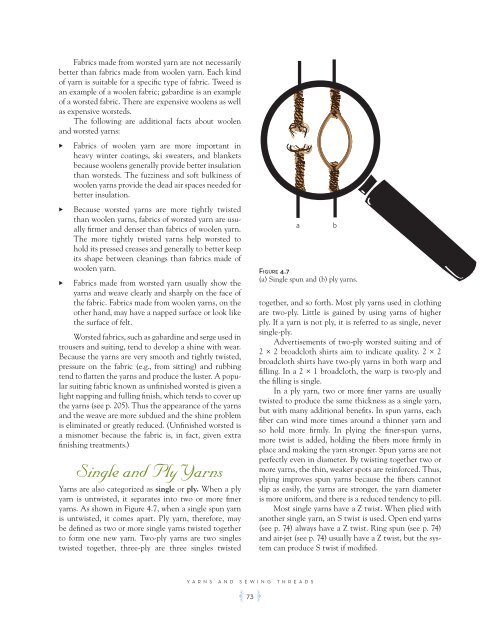Create successful ePaper yourself
Turn your PDF publications into a flip-book with our unique Google optimized e-Paper software.
<strong>Fabrics</strong> made from worsted yarn are not necessarily<br />
better than fabrics made from woolen yarn. Each kind<br />
of yarn is suitable for a specific type of fabric. Tweed is<br />
an example of a woolen fabric; gabardine is an example<br />
of a worsted fabric. There are expensive woolens as well<br />
as expensive worsteds.<br />
The following are additional facts about woolen<br />
and worsted yarns:<br />
u <strong>Fabrics</strong> of woolen yarn are more important in<br />
heavy winter coatings, ski sweaters, and blankets<br />
because woolens generally provide better insulation<br />
than worsteds. The fuzziness and soft bulkiness of<br />
woolen yarns provide the dead air spaces needed for<br />
better insulation.<br />
u Because worsted yarns are more tightly twisted<br />
than woolen yarns, fabrics of worsted yarn are usually<br />
firmer and denser than fabrics of woolen yarn.<br />
The more tightly twisted yarns help worsted to<br />
hold its pressed creases and generally to better keep<br />
its shape between cleanings than fabrics made of<br />
woolen yarn.<br />
u <strong>Fabrics</strong> made from worsted yarn usually show the<br />
yarns and weave clearly and sharply on the face of<br />
the fabric. <strong>Fabrics</strong> made from woolen yarns, on the<br />
other hand, may have a napped surface or look like<br />
the surface of felt.<br />
Worsted fabrics, such as gabardine and serge used in<br />
trousers and suiting, tend to develop a shine with wear.<br />
Because the yarns are very smooth and tightly twisted,<br />
pressure on the fabric (e.g., from sitting) and rubbing<br />
tend to flatten the yarns and produce the luster. A popular<br />
suiting fabric known as unfinished worsted is given a<br />
light napping and fulling finish, which tends to cover up<br />
the yarns (see p. 205). Thus the appearance of the yarns<br />
and the weave are more subdued and the shine problem<br />
is eliminated or greatly reduced. (Unfinished worsted is<br />
a misnomer because the fabric is, in fact, given extra<br />
finishing treatments.)<br />
Single and Ply Yarns<br />
Yarns are also categorized as single or ply. When a ply<br />
yarn is untwisted, it separates into two or more finer<br />
yarns. As shown in Figure 4.7, when a single spun yarn<br />
is untwisted, it comes apart. Ply yarn, therefore, may<br />
be defined as two or more single yarns twisted together<br />
to form one new yarn. Two-ply yarns are two singles<br />
twisted together, three-ply are three singles twisted<br />
YARNS AND SEWING THREADS<br />
A 73 F<br />
a b<br />
Figure 4.7<br />
(a) Single spun and (b) ply yarns.<br />
together, and so forth. Most ply yarns used in clothing<br />
are two-ply. Little is gained by using yarns of higher<br />
ply. If a yarn is not ply, it is referred to as single, never<br />
single-ply.<br />
Advertisements of two-ply worsted suiting and of<br />
2 × 2 broadcloth shirts aim to indicate quality. 2 × 2<br />
broadcloth shirts have two-ply yarns in both warp and<br />
filling. In a 2 × 1 broadcloth, the warp is two-ply and<br />
the filling is single.<br />
In a ply yarn, two or more finer yarns are usually<br />
twisted to produce the same thickness as a single yarn,<br />
but with many additional benefits. In spun yarns, each<br />
fiber can wind more times around a thinner yarn and<br />
so hold more firmly. In plying the finer-spun yarns,<br />
more twist is added, holding the fibers more firmly in<br />
place and making the yarn stronger. Spun yarns are not<br />
perfectly even in diameter. By twisting together two or<br />
more yarns, the thin, weaker spots are reinforced. Thus,<br />
plying improves spun yarns because the fibers cannot<br />
slip as easily, the yarns are stronger, the yarn diameter<br />
is more uniform, and there is a reduced tendency to pill.<br />
Most single yarns have a Z twist. When plied with<br />
another single yarn, an S twist is used. Open end yarns<br />
(see p. 74) always have a Z twist. Ring spun (see p. 74)<br />
and air-jet (see p. 74) usually have a Z twist, but the system<br />
can produce S twist if modified.













